Crafting Fries from Scratch: A Complete Guide to Perfection

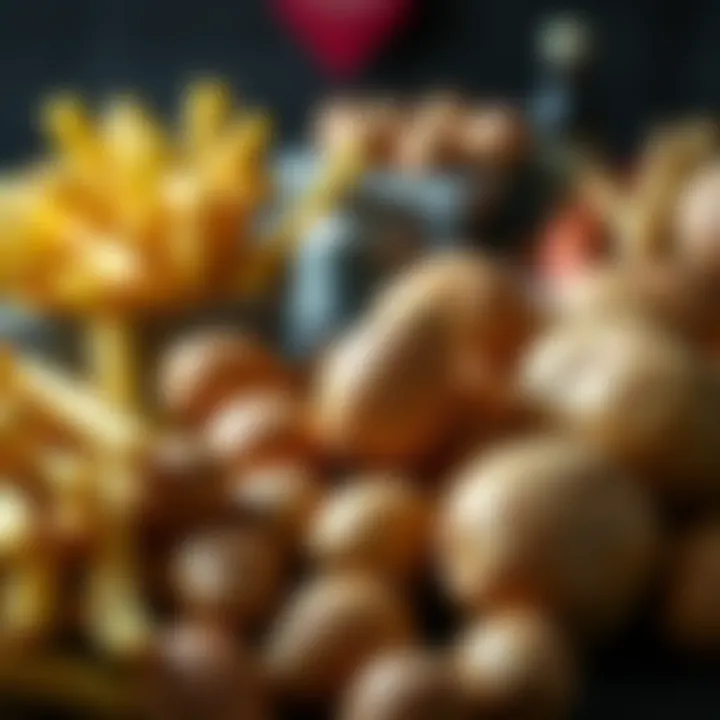
Intro
Making fries from scratch is an experience that transcends merely satisfying a craving; it's a culinary adventure that combines art and science. If you’ve ever savored a perfectly crispy fry, chances are you’ve felt that special connection to this simple yet complex dish. Directed by the hands of tradition and catered to contemporary tastes, crafting fries invites exploration of flavors, textures, and cooking techniques.
In this guide, readers will journey through the essential aspects of fry-making—from selecting the perfect potatoes to experimenting with various preparation styles. This is more than just about potato slices; it’s about understanding the nuances of ingredients and methods that lead to that golden, crispy result that dances on your palate.
Whether you are a seasoned home cook or just starting out in the kitchen, you will find valuable insights here, including tips tailored to different dietary needs. So, pull out your apron, and let's delve right into the ingredients you’ll need to kick off this delightful endeavor!
Understanding Potatoes
The foundation of any great fries lies in the potatoes themselves. Knowing the type and quality of potatoes you choose can make all the difference between a soggy mess and a crispy delight. Potatoes come in various shapes, textures, and flavors, each with its own unique profile. This section delves into selecting the right potatoes and understanding their characteristics, empowering you to make informed choices when crafting your personalized fries.
Types of Potatoes for Fries
Russet Potatoes
Russet potatoes are often regarded as the gold standard for making fries, and for good reason. They have a high starch content, which means they turn out fluffy on the inside while achieving that coveted crispy exterior when cooked.
The key characteristic here is their size; they are large and elongated, providing ample flesh to create variety in cuts. This is a beneficial choice for those looking to serve up classic fries since they hold their shape and texture well during cooking. However, they can be prone to dark spots, which may affect the visual presentation of your fries, and overly long cooking times will lead to them being too dry.
Yukon Gold Potatoes
Yukon Gold potatoes bring a delightful twist to the table. Their creamy texture and buttery flavor make them a popular choice, especially in gourmet settings. When cut into fries, they offer a rich, distinct taste, setting them apart from your typical russets.
The unique feature of Yukon Golds lies in their yellow flesh, which can add an inviting color to your plate. However, they have a medium starch content, which means they tend to be slightly less crispy compared to Russet fries. But if you’re after a more flavorful option, Yukon Golds can be a solid candidate.
Red Potatoes
When it comes to red potatoes, you're looking at a different ball game. These potatoes have a waxy texture with lower starch content, making them less ideal for traditional crispiness associated with fries. Nonetheless, they hold their shape well, which means they can be used for enjoying roasted or baked variations or even in salads.
A key characteristic of red potatoes is their thin skin and slightly sweet flavor. This makes them a good choice for those who prefer a softer, more tender fry. Their disadvantage lies in the texture; they might not satisfy a fry lover’s desire for that golden crunch.
Sweet Potatoes
Sweet potatoes are a favorite for those looking to introduce a nutritious twist to their fries. Their natural sweetness brings a different flavor profile, making them a beneficial choice for experimental cooks. Sweet potatoes have complex carbohydrates and a higher nutritional value than standard potatoes.
The unique feature of sweet potatoes is their vibrant color, ranging from orange to purple. This not only makes them visually appealing but also adds a flavorful punch to your dishes. However, sweet potatoes can be trickier to fry because of their sugar content, which may lead to faster browning and burning during the cooking process. This could be seen as a disadvantage, but many love their sweet and savory combination.
Starch Content and Its Effect
Understanding Starch Types
Understanding the types of starch present in potatoes creates an essential foundation for crafting perfect fries. Essentially, starch is categorized into two types: amylose and amylopectin. High-amylose potatoes, like russets, achieve that crispy fried texture, whereas low-amylose varieties, such as red potatoes, tend to be waxy and may not give you the crunch you're after.
This distinction is crucial. Higher starch content means better frying potential, translating generally to better texture and flavor satisfaction. If you prioritize crispy fries over a creamy interior, knowing your starch types can be a game-changer in your kitchen.
Impact on Texture and Taste
The impact of starch on the final product goes beyond texture; it also influences taste. When you cook starch, it gelatinizes and results in a fluffy interior with a crispy surface. This key characteristic makes choosing the right potato a vital step in ensuring the overall delight of your fries.
The unique feature here is the balance between the frying method and potato type; getting both right allows you to develop varied textures and flavors. When using the right potatoes, the impact on taste is significant—different potatoes can yield vastly different taste experiences, enhancing your culinary adventure.
Preparation Techniques
When you step into the kitchen to craft your fries, getting the preparation techniques just right is paramount. This section focuses on the often-overlooked foundation of making great fries: how you handle your potatoes prior to cooking. Preparing your potatoes involves more than simple cutting; it lays the groundwork for texture, flavor, and overall satisfaction.
Choosing the Right Knife Skills
Knife skills can significantly affect the final product. Each cut not only dictates the visual appeal but also influences how the fries cook. Thus, knowing your cuts can pave the way for better fries.
Julienne Cuts
Julienne cuts are long, thin strips of potato, ideal for achieving that coveted crispy texture. When prepared this way, the fries increase their surface area, allowing for more of that golden crunch when cooked. This method is particularly beloved because it maximizes frying efficiency. The high surface-to-volume ratio means that julienne-cut fries get crispy on the outside while still retaining a soft interior.
Although julienne cuts yield delightful results, beware the potential inconsistency in thickness. If not done thoughtfully, some fries may cook faster than others, leading to a less than optimal experience.
Matchstick Cuts
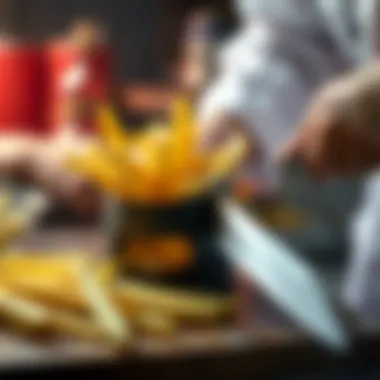
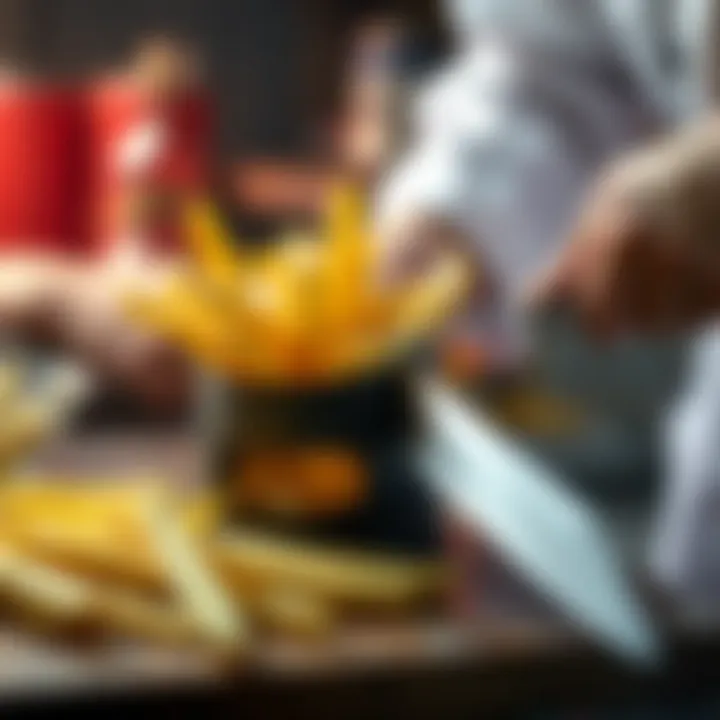
Matchstick cuts are shorter and similarly thin like the julienne but tend to have a slightly different application. These fries, often around the size of a matchstick, can cook quickly and evenly. They're a favored choice when seeking to create a perfect balance of crispiness and creamy potato goodness inside. Their size allows for rapid frying, so timing is crucial; overcooking can lead to a burnt flavor.
The appeal of matchstick cuts lies in their uniformity, making them a sound choice for those keen on precision. On the flip side, their thin nature means they can be prone to breaking when handled too much.
Steak Fries vs. Thin Fries
When considering steak fries versus thin fries, one might think of the differences in their heartiness. Steak fries are thicker and maintain a substantial bite, making them a go-to for those who favor a heavier, more filling fry. However, they typically require longer cooking times, balancing the need for tenderness inside against achieving that crisp outer shell.
Conversely, thin fries offer a lighter option and are often seen as snackable. Their rapid frying process means they can be ready in no time, but they need careful attention to avoid overcooking. Ultimately, the choice between steak and thin fries hinges on personal preference, and both can deliver satisfaction if executed with care.
Soaking Potatoes
Another essential preparation technique involves soaking the potatoes. This might seem a minor step, but its significance in the frying process can't be overstated. Soaking helps to extract excess starch from the potatoes, reducing the risk of fries that clump together or become gummy during cooking.
Benefits of Soaking
The primary advantage of soaking potatoes is the enhancement of their crispiness. By removing excess starch, the fries develop a better texture; they brown more evenly and have a delightful crunch. Soaking also helps in creating a prized exterior that many crave when biting into a fry.
That said, soaking is not merely a matter of taste but also a practical consideration. Depending on the potato variety, soaking times may vary; too long can lead to a waterlogged fry, while too short won't allow enough starch removal.
Timing and Techniques
Timing is key when soaking. A good rule of thumb is to soak fries for at least 30 minutes but not more than a couple of hours. Experimenting with this process can yield valuable insights into how different soaking times affect texture. Techniques can also vary; some prefer cold water for soaking, while others might advocate for warm water to expedite the process, though this approach may come with its own set of risks for the integrity of the potato.
Cooking Methods
Understanding how to cook fries properly can make all the difference when it comes to flavor and texture. Cooking methods for fries vary significantly, but each has its merits. This section dives into the various ways you can prepare fries, bringing out their unique qualities. The right cooking method not only affects how the fries taste, but it also alters their nutritional value, making these choices crucial for any home cook.
Frying Techniques
Deep Frying
Deep frying is often considered the gold standard when it comes to creating that crispy, golden-brown fry. The potato pieces are submerged into hot oil, which ensures even cooking and frying. A key characteristic of deep frying is the quick cooking time, which seals in moisture while giving a crisp exterior. This method bids farewell to soggy fries, making it a favored choice among enthusiasts and fast-food chains alike.
- Benefits: The fast cooking results in a texture that’s hard to beat. Golden, crispy, and soft on the inside, these fries can be delightful distractions.
- Drawbacks: There is, of course, the issue of additional calories to contend with, not to mention the cleanup that comes with oil management. However, a well-executed deep fry can justify its shortcomings.
Shallow Frying
Shallow frying, in contrast, only partially submerges fries in oil. This method is easier on the health front since it calls for less oil, making it a popular approach for those who want to cut down on calories. When done right, shallow frying can yield a satisfying crunch with less mess. The fries take on a slightly different character—less evenly crisp, but more flavorful due to the enhanced potato surface exposure to the heat.
- Benefits: It requires less oil, which can make it a more economical choice. It may also be easier to control doneness and color.
- Drawbacks: You might end up with some unevenly cooked fries. Some may be perfectly crispy while others may be a bit softer; thus, it's imperative to maintain consistent heating.
Double Frying Method
The double frying method is all about precision and technique. This method involves frying the fries twice at different temperatures. The first fry cooks the potatoes through at a lower temperature, while the second fry at a higher temp creates that delightful crispiness on the outside.
- Key characteristic: It's like giving your fries a spa day—softening them first and then pampering them with heat to achieve the ultimate crunch.
- Benefits: Achieving a perfect fry—crispy on the outside and fluffy inside—makes this a choice for those dedicated to craftsmanship in the kitchen.
- Drawbacks: It requires an extra step, and the longer frying process could be seen as tedious for some, but the results speak for themselves.
Oven-Baked Fries
Oven-baked fries provide an alternative for those looking for a healthier yet tasty option. Baking allows for a lower fat content, while still delivering satisfying outcomes if executed well.
Oil Application Techniques
In the world of oven-baked fries, how you oil them matters. Using a light coating versus heavy drenching can change the outcome significantly. Good technique here means choosing the right kind of oil and method to apply it. For example, light sprays or tossing in a bowl to ensure even coverage can promote a crispy texture.
- Benefits: Less oil means fewer calories, and it’s easier to control the amount compared to frying.
- Drawbacks: Some may find that they miss the richness of deep-fried alternatives, but cleverly seasoning can bridge that gap.
Temperature and Timing
Practicing precise timing and temperature settings can elevate your oven-baked fries. Typically, a higher temperature of about 425°F ensures a nice exterior brown, while the right timing—around 25 to 30 minutes—helps establish the right level of doneness. Monitoring during cooking is key to preventing a charred finish.
- Benefits: More convenience as you can bake a larger batch at once. Better for groups without frying in batches.
- Drawbacks: It requires patience while they cook without the immediate gratification of oil.
Air Frying
Air frying enters the scene as a modern alternative to traditional frying methods. This technique utilizes hot air circulation to achieve a crispy texture with significantly less oil.
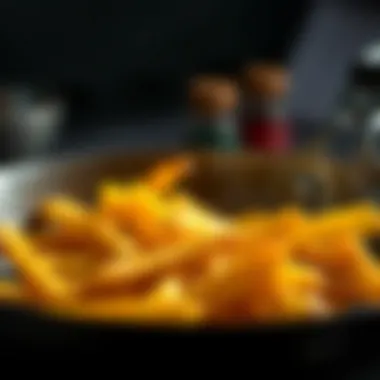
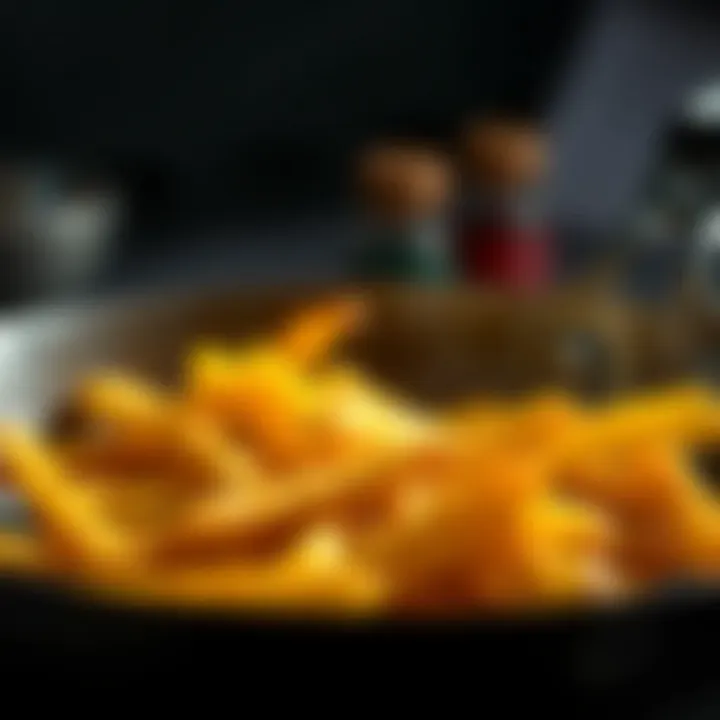
How Air Fryers Work
Air fryers create a cyclone of hot air that envelopes food, resulting in a crispy exterior with a fluffy interior. The key techniques focus on consistent airflow to cook evenly. This method is beneficial in saving time and reducing excess fat in your dish.
- Benefits: It’s a healthy option that still feels indulgent without having to dip deep into oil.
- Drawbacks: Some maintain the texture just doesn’t compare to oil frying, as it can leave some lacking in that signature fry crunch.
Adjusting Cooking Times
Air fryers differ from standard frying installations, meaning cooking times are crucial for achieving the desired outcome. Because air fryers often cook quicker, adjustments to timing might be required to avoid burnt edges or undercooked centers.
- Benefits: Faster cooking time can be a win for those in a hurry.
- Drawbacks: This speed means careful attention to avoid those dreaded less-than-ideal results.
Enhancing Flavor
When it comes to crafting the perfect fries, the taste can make or break the experience. Enhancing flavor is not just an afterthought; it is a fundamental step in elevating these golden delights from mere side dishes to standout stars in their own right. The role of seasoning cannot be overstated, as it transforms plain potatoes into something that tantalizes the taste buds and complements the overall dining experience. Tailoring seasoning choices to suit your personal palate adds an extra layer of creativity, allowing you to experiment and discover what works best for you. In this section, we'll delve into various seasoning options that can brighten up your fries and a few dipping sauces that could take the whole affair to new heights.
Various Seasoning Options
Classic Salt and Pepper
Classic salt and pepper are the simplest yet most effective way to enhance fries. Salt acts as flavor magnifier, elevating the natural sweetness of the potatoes while pepper introduces a subtle kick. The beauty of this combo lies in its universal appeal. It's so familiar that people often overlook its effectiveness.
That being said, the careful balancing of the two is crucial. Too little salt, and the fries can feel bland; too much, and it may overshadow the potato flavor. A light sprinkle right after frying always offers a finishing touch that many would recognize.
Advantages include its simplicity, affordability, and instant accessibility. Disadvantages? It can be overly familiar—some may perceive it as lacking creativity.
Gourmet Blends
Why not shake things up a tad with gourmet blends? One key characteristic is their ability to provide a more complex flavor profile compared to the standard salt and pepper. These blends can incorporate ingredients like smoked paprika, garlic powder, or even fancy sea salts. They can be fun to experiment with and can tell a story or complement the meal's theme.
Gourmet blends are a great option if you're looking to impress. The unique features foster an adventurous spirit in your cooking approach, though they can sometimes be financially draining or difficult to source.
Herbs and Spices
Herbs and spices can elevate the humble fry into a gourmet experience. From rosemary and thyme to cumin and chili powder, there's a wide array to choose from. What makes herbs and spices so appealing is their versatility and the dimension they add. You can create a Mediterranean theme by using oregano and basil or go all-in on a spicy vibe with cayenne pepper.
However, the challenge can rest in finding the right balance; you don’t want the seasoning overshadowing the potato taste. While they offer a plethora of flavors, they might not be as universally accepted, especially for those who prefer milder tastes.
Creating Dipping Sauces
A fry is often incomplete without a dipping sauce by its side, and homemade sauces can encapsulate your culinary efforts beautifully.
Homemade Ketchup
This classic condiment has its roots deep in food culture, but making it at home stands out. Homemade ketchup can be tailored to suit your taste—be it sweeter, spicier, or tangier. The key characteristic here is that you control the ingredients, often making it healthier by reducing sugars and additives.
Creating homemade ketchup allows for customization and lends a personal touch, but it does require some kitchen time that may put off some.
Garlic Aioli
Garlic aioli is a luxurious addition that links perfectly to fries. With its rich, creamy texture and a punch of garlic flavor, it's sophistication in a small bowl. One can mix it up by adding lemon juice or herbs to suit individual preferences, further enhancing individual flavors.
The flip side? The calories may run high compared to simpler sauces, but for garlic lovers, the trade-off may be worth every indulgent bite.
Spicy Mayonnaise
If you're looking to bring the heat, spicy mayo ought to be considered. Blending mayonnaise with ingredients like Sriracha or chipotle gives a delightful kick that can tantalize the senses. The creamy base softens the spice, making it approachable even for those not keen on fiery flavors.
The downside, much like the aioli, lies in the calorie count, and it might not be suitable for those avoiding eggs or dairy products. That said, it does allow for custom spiciness levels, making it a popular choice among thrill-seeking palates.
These flavor-enhancing strategies provide a comprehensive approach to ensure your fries not only meet taste expectations but exceed them. By exploring various seasonings and dips, you arm yourself with the tools to craft fries that will leave an impression.
Health Considerations
Understanding the health aspects of crafting fries from scratch is essential for anyone who wants to enjoy this beloved dish without compromising their health goals. Comfort food doesn’t always have to lead to guilt; with a bit of creativity and knowledge, you can make fries that are not only satisfying but also nutritious. It’s worthwhile to consider several factors, from ingredient choices to cooking methods, which can significantly impact the health profile of your homemade fries.
Moreover, as dietary needs and preferences evolve, knowing the healthier alternatives and nutritional breakdown can help you make informed decisions that align with a balanced diet.
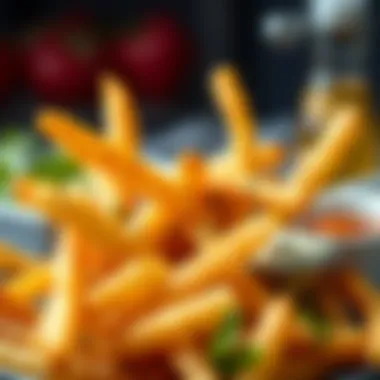
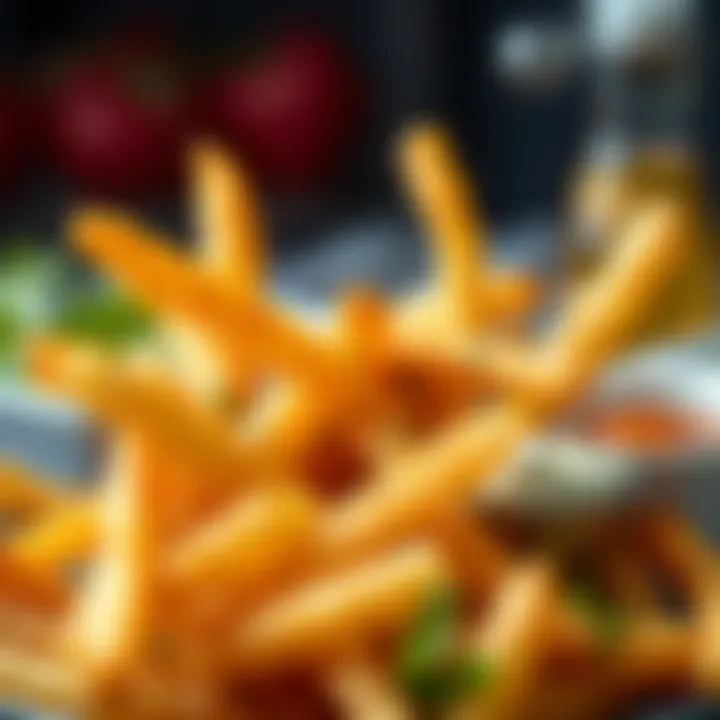
Healthier Alternatives
Using Olive Oil
Using olive oil for frying or baking fries provides a heart-healthy alternative to traditional oils. Rich in monounsaturated fats, olive oil is known for its beneficial properties, including lowering bad cholesterol and reducing inflammation. Unlike many vegetable oils which may have high levels of omega-6 fatty acids, olive oil is generally viewed as a better option for maintaining heart health.
The unique characteristic of olive oil is its flavor profile. It adds a subtle richness to the fries, making them both healthier and tastier. However, keep in mind that since olive oil has a lower smoke point, it might not be suitable for very high-temperature frying.
Baking Instead of Frying
Baking fries instead of frying them significantly cuts down on the added fats and calories. This method involves using less oil while allowing for crispness, especially if you give them a good coat of olive oil and seasonings beforehand. Baking also opens the door to achieving a healthier and lighter texture, which can be especially attractive for those watching their fat intake.
Although baked fries might not replicate the same luxurious crunch as fried ones, they can still be delicious when seasoned properly and cooked at the right temperature. It’s all about finding that perfect balance and experimenting with techniques.
Exploring Vegetable Varieties
Diving into different vegetable varieties for your fries can also provide a healthy twist on the classic. Think beyond potatoes; you might find that veggies like zucchini, parsnips, or carrots can make for delightful alternatives. Each has its unique flavor and nutritional profile, offering a range of vitamins and minerals that white potatoes might lack.
Opting for vegetable variations increases fiber and nutrient intake while maintaining the fun of eating fries. However, the texture and cooking times will vary, so it’s important to consider how each vegetable behaves when turned into fries.
Nutritional Breakdown
Caloric Content of Potatoes
The caloric content of potatoes often raises concerns, especially among those watching their weight. On average, a medium-sized russet potato contains about 160 calories. While that may sound like a lot, it's essential to remember that most of the calories come from carbohydrates, which provide energy. Moreover, potatoes are also rich in vitamins like Vitamin C and B6.
The key here is portion control and how you choose to prepare them. By crafting your fries from scratch, you can control what goes on them, making it easier to keep your calorie intake in check while still enjoying this treat.
Fat Content in Cooking Methods
The fat content of fries varies significantly based on the cooking method employed. For instance, deep-frying can pack a hefty amount of fat into fries, while shallow frying or baking can be much lighter. On average, restaurant fries can contain 20-30 grams of fat per serving when deep-fried.
By opting for different cooking techniques like air frying or baking with minimal oil, you can achieve much lower fat content in your fries. This knowledge is vital for anyone aiming to enjoy fries while being mindful of their fat intake.
Nutritional Benefits of Sweet Potatoes
Sweet potatoes are a powerhouse of nutrients and can be a wise alternative to traditional russet potatoes. Not only do they offer a deliciously sweet flavor, but they are also packed with nutrients such as Vitamin A, Vitamin C, and potassium. Sweet potatoes contain antioxidants that can help combat oxidative stress in the body, contributing to overall health.
Including sweet potato fries in your diet not only adds variety but also brings numerous health benefits. However, be cautious with preparation methods as frying them can still lead to higher calorie intake. When baked or air-fried, sweet potatoes can be a vibrant, nutritious addition to your meals.
Presentation and Serving
The way you present your fries can elevate them from a mere side dish to a centerpiece of a meal. Presentation is not just about making your dish look good; it enhances the dining experience and can even influence the perception of flavor. When fries are garnished nicely or served in an intriguing way, they seem more appetizing. This section will delve into effective plating techniques and the best food pairings to maximize your fried potato experience.
Plating Techniques
Choosing the Right Dish
Selecting the right dish for serving fries contributes to their overall appeal and experience. A shallow bowl can keep fries closer together, emphasizing their crispy texture, while a longer plate can help them retain warmth longer. Color and material also play a role. A white plate not only contrasts the golden-brown color of fried potatoes but also allows them to pop visually.
When serving fries, one common choice is a rustic wooden board. This adds an earthy, homey feel that resonates with comfort food enthusiasts. Another option, like a sleek porcelain dish, offers a modern aesthetic. Both choices should consider practicality too—using a dish that fits the portion size while making it easy for guests to take those delicious bites.
Each of these options brings benefits depending on the setting: casual gatherings versus formal dinners.
Garnishing for Appeal
Garnishing fries can significantly enhance their presentation. A sprinkle of freshly chopped herbs, such as parsley or chives, adds a pop of color and a hint of freshness which complements the fried flavor. Using a dusting of artisan salts or a drizzle of specialty oils can infuse additional flavor and elevate the appearance.
Another clever way to garnish is to serve fries with visually appealing dips on the side. For example, a vibrant red ketchup in a small ramekin next to a creamy garlic aioli can stimulate taste buds even before the fries hit the lips. This method also allows diners to customize their experience, adding to the fun of eating out.
Pairing with Main Dishes
Burgers and Sandwiches
Burgers and fries are a classic duo that never goes out of style. The key characteristic here is the well-balanced contrast between the juicy, savory taste of the burger and the crispy, starchy goodness of fresh fries. Pairing these two not only enhances the flavor combinations but also creates a fulfilling meal. Take a hearty beef burger, for instance; it complements the fries perfectly by contrasting textures: where the burger is soft, the fries provide that satisfying crunch.
However, one must be cautious with portions. Offering a massive burger alongside an equally large helping of fries might overwhelm diners, leading to food waste. Balancing the servings is crucial for maximizing enjoyment.
Salads and Wraps
The pairing of fries with salads and wraps presents a unique twist on traditional meal combinations. This option allows for a lighter meal that incorporates a range of textures and tastes. For instance, the crispiness of fries can add a satisfying crunch to a fresh garden salad, breaking the mundane tomatoes and cucumbers mix. Additionally, wrapping fries in a soft tortilla not only makes them portable but also creates a fun, hand-held finger food experience.
However, one must consider the dressing and its impact. A creamy dressing on a salad may not harmonize as well with the fried texture, leading to an overwhelming flavor profile. Finding the right balance is essential for a satisfying meal.
Remember: Presentation not only enhances the look of the dish, but it creates an experience that diners will remember and cherish.







